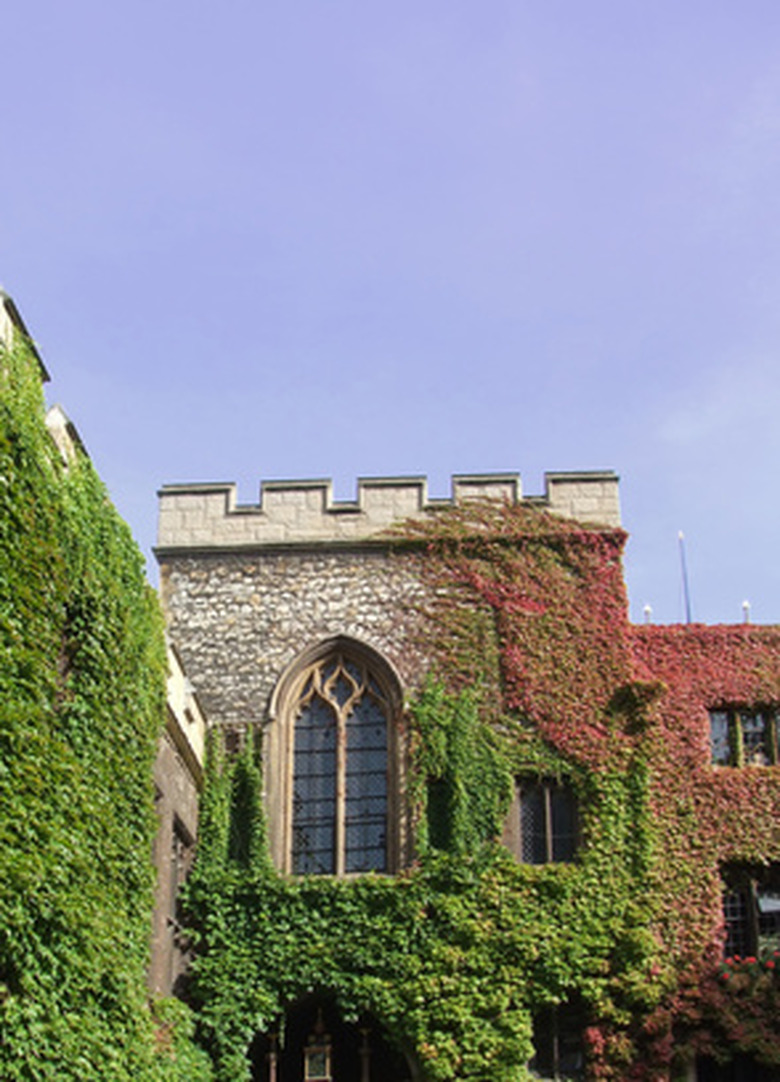Problems With Boston Ivy
Boston ivy (Parthenocissus tricuspidata) is a deciduous climbing vine that is often seen growing on buildings. Valued for its green summer and purple fall foliage, this vine is often used to shade brick and stone structures while adding visual interest–although it has been known to damage masonry. Boston ivy can grow up to 30 feet tall and wide and prefers cool, moist soil but can also tolerate shady conditions. While known as a fairly hardy plant, it can suffer from a few common problems.
Spider Mites
Spider mites are tiny, red or white insects that can infest Boston ivy, especially when it is growing in hot, dry conditions. The mites, which suck on the plant juices, cause the leaves of Boston ivy to become spotted, covered with thin white webs, and discolored. While the spider mites themselves do not cause enough damage to kill a mature Boston ivy plant, they can weaken it significantly, causing the leaves to drop and making the plant vulnerable to diseases and other insect pests. Pesticides specifically formulated for spider mites should be used, as general insecticides can kill beneficial predators of these pests.
- Boston ivy (Parthenocissus tricuspidata) is a deciduous climbing vine that is often seen growing on buildings.
- Valued for its green summer and purple fall foliage, this vine is often used to shade brick and stone structures while adding visual interest–although it has been known to damage masonry.
Japanese Beetles
Japanese beetles hatch in early spring and live for only 30 days. In that time, a swarm of them can completely skeletonize a Boston ivy plant. These insect pests feed on the foliage of ivy and other plants, leaving behind only the veins of the leaves.
While Japanese beetles are currently limited to the eastern United States, they are spreading rapidly. They do not have many natural predators and are very difficult to control. While there are some pesticides marketed to kill Japanese beetles, they do not usually kill the beetle in its underground grub form. This allows new beetles to develop. For that reason, it is simply best to remove the beetles by hand if you have a small Boston ivy plant.
- Japanese beetles hatch in early spring and live for only 30 days.
- While there are some pesticides marketed to kill Japanese beetles, they do not usually kill the beetle in its underground grub form.
Guignardia Leaf Spot
Guignardia leaf spot is a fungal disease that attacks vines and some other climbing plants. It is caused by the fungus Guignardia bidwellii. This fungus multiplies in the cool, moist condition favored by these plants. Guignardia overwinters in the ground on decaying leaves and can also spread on drops of water, such as rain blown about in the wind.
Boston ivy plants infected with this fungal disease will have leaves that are spotted pale brown ringed with a black border. Sometimes the spots drop out of the leaves, leaving them with holes. Other times the spots spread, and the leaves become brown and withered. Guignardia leaf spot will not kill a Boston ivy plant, but it will leave it looking quite unattractive. Prevent this fungus by making sure fallen ivy leaves are raked up. You can also spray the ivy with a preventative fungicide in the spring.
- Guignardia leaf spot is a fungal disease that attacks vines and some other climbing plants.
- Guignardia overwinters in the ground on decaying leaves and can also spread on drops of water, such as rain blown about in the wind.
